Featured Text
Sandy Calder, forgeron lunaire
Cahiers d’Art, nos. 20–21 (1945–46). Translation courtesy “Calder in France,” Cahiers d’Art, no. 1 (2015).
Cahiers d’Art, nos. 20–21 (1945–46). Translation courtesy “Calder in France,” Cahiers d’Art, no. 1 (2015).
Je me souviens d’un temps fort lointain déjà, où les artistes, les connaisseurs et amateurs d’Art pleuraient et vitupéraient parce que dans le ciel de Paris la silhouette de la tour Eiffel venait de s’élever, imprimant sur l’air ses filigranes d’acier, dominant les tours et les flèches de pierre, forçant la curiosité et même déjà l’admiration. Blasphème triomphant de tous les dogmes de l’Architecture et de la Beauté.
Il est assez difficile de se figurer de nos jours les grands bouleversements qu’a entraînés dans tous les domaines de la vie (matériels, spirituels et sociaux) l’éclosion scientifique du siècle dernier ; et comment les raisons même de l’Art ont été atteintes, désagrégées, transportées peu à peu par étapes successives sur un plan nouveau de la conscience et de la connaissance.
Non point que je prétende que n’existe plus dans les générations actuelles ce besoin de l’activité mystérieuse de l’Art. Activité qui se formule par la recherche et l’utilisation purement gratuite des capacités sensorielles et de l’imagination. Jeux d’une logique transcendante, qui, par équilibres, proportions, gradations, insuffle à tout thème choisi visuel, musical ou verbal un commencement et une fin, une “réalité” arbitraire dont les caractères s’imposent à celui qui en reçoit le choc, comme l’œil reçoit la lumière. Ce sont les éléments de réalisation, la règle du jeu, les matières et les canons qui, sous la poussée d’intérêts nouveaux, se sont peu à peu entièrement transformés et transposés. Je parle ici particulièrement des arts plastiques qu’a bouleversés la mise au point de la photographie et du cinématographe. L’histoire de l’Art des cinquante dernières années, c’est l’histoire de cette désagrégation et de cette réformation.
De la tour Eiffel, gageure blasphématoire, à Calder, Sculpteur de Vent, Forgeron Lunaire, que de chemin parcouru.
L’œuvre qu’il nous apporte d’outre-Atlantique est un témoignage flagrant de cette position nouvellement acquise des Arts plastiques ; témoignage d’autant plus précis qu’il ne semble pas que Calder ait jamais connu les angoisses, les doutes de la “désintégration” des objets et des sujets qui ont tourmenté la génération de ses aînés, ni les querelles quelque peu puériles autour de l’Abstrait et du Concret qui sont encore actuellement de mise pour certains. Il est parti de la dernière étape avec la sûreté d’une génération déjà bien établie sur ses conquêtes. Il faut ajouter à ce “point” spirituel certaines caractéristiques inhérentes à ses origines yankees, et noter aussi comme un fait nouveau que loin de les renier il les a utilisées à l’extrême, échappant à la formation classique, rigide et périmée qui a dominé jusqu’à nos jours les goûts des artistes d’Amérique et jugulé leurs tentatives originales. Ceci est d’autant plus remarquable que son père et sa mère ont été des artistes officiels, localement très réputés. Il fait partie de cette génération neuve d’intellectuels américains que nous connaissons surtout par des œuvres littéraires de terroir. Elles nous révèlent des tempéraments et des intérêts très éloignés de la tessiture européenne, résolument braqués sur l’avenir et les apports de la connaissance scientifique, ce qui d’ailleurs n’empêche pas le souvenir latent des ancêtres pionniers et la nostalgie de leurs contacts et débats avec la nature vierge.
Sandy Calder, plus touché par le dynamisme mécanique que par l’ambiance artistique dans laquelle il a été élevé, fera pendant quatre ans des études d’ingénieur qui le marqueront définitivement. Il sera aussi chauffeur à bord d’un cargo, bûcheron dans l’une de ces forêts gigantesques que nous font connaître les documentaires cinématographiques. Expériences dont il rapporte sans doute cette carrure d’épaules qui lui donne l’aspect d’un bloc détaché de la montagne.
N’ayant pas réussi ses examens d’ingénieur, Calder pense de nouveau aux arts qui n’ont pas cessé de le hanter. De son temps de bûcheron il a rapporté des peintures et se montre fier d’avoir fait tenir sur l’une de ses toiles les trois montagnes couvertes de neige qui entourent sa forêt ; souci fort éloigné des recherches picturales proprement dites, telles que nous les entendons. Il apprend à dessiner avec un ami de sa mère. Il fait des dessins pour le Police-Magazine. Mais il est surtout doué d’une adresse manuelle surprenante. Il est presque émouvant de voir ses mains puissantes, véritables pattes d’éléphant, toucher, triturer avec une pince de mécano (son outil de prédilection) de minces fils de fer qui en sortent, silhouettes ou bijoux, objets utilitaires ou imaginaires, portant le sceau caractéristique de sa manière.
J’ai connu en 1932 la maison que Calder habitait à Paris, rue de la Colonie, et me suis souvent délectée en découvrant les améliorations qu’il avait apportées aux servitudes de la vie usuelle et ménagère. Dans la cage de l’escalier des fils pendaient du faîte au sol, permettant d’ouvrir la porte de la maison du dernier étage sans se déranger, ou y apportant le courrier. La cuisine et la salle de bains étaient les lieux d’élection de ses truquages ingénieux. Dans la salle de bains un petit drapeau rouge apparaissant mystérieusement avertissait que la veilleuse du chauffe-eau, maladroitement située, était allumée. Les tiroirs, les robinets, s’agrémentaient d’arabesques en fils de fer ou de cuivre, appareils utilitaires faciles à manier autant que porteurs d’une inconsciente exigence plastique.
Mais Calder était venu en Europe dès 1926. Là commence sa grande aventure. Il visite la France et l’Angleterre où, pour gagner sa vie, il repeint le cargo qui l’a amené. A Paris il se sent à l’étroit, il manque d’air, il ne se mélange pas aux milieux d’art, il danse au Dôme, il fabrique des jouets animés, sortes de marionnettes actionnées par des commandes en ficelle qui sont déjà l’indice de ce qu’il porte en lui. Ces petits personnages schématiques et pourtant d’un réalisme aigu, articulés pour une exagération humoristique de leurs caractères, ne donnent leur capacité de dynamisme que lorsqu’ils sont en mouvement. Leur conception, autant que l’habileté de leur exécution, touche au chef-d’œuvre. Ainsi : Joséphine Baker dont le ventre est fait d’un serpentin de cuivre qui vibre à la moindre pression sur les commandes et déclenche dans un corps à peine silhouetté son irrésistible trémoussement érotique. De même le “Jeu des Boxeurs,” la “Marche des animaux,” etc. On retrouve actuellement dans les récents dessins du “Jeu d’Echecs” le même esprit humoristique. La Reine, libidineuse, les Cavaliers, entreprenants, le Roi, apeuré, les Pions, robots obtus, m’ont surtout charmée. Marcel Duchamp a ajouté quelques bons calembours à ces dessins qui sont de la classe de l’esprit des meilleurs dessins animés d’Hollywood. Les représentations du Cirque miniature dont Calder est l’auteur et l’opérateur, et pour lequel il fait un commentaire savoureux, lui vaudront une célébrité inattendue dans des milieux très divers. On l’appelle le roi du fil de fer et de la ficelle. Mais cette célébrité est loin de le satisfaire. Il cherche autre chose. Il rentre aux Etats-Unis où pendant un an il sculptera du bois. Entre-temps il connaît Léger, Miró, Mondrian, ce dernier surtout lui fait une profonde impression ; sans doute ces rencontres seront-elles le levain des aspirations encore confuses qui le tourmentent. Elles l’aideront à libérer sa personnalité, tandis que son génie du bricolage servira de truchement.
En 1932 la maison de la Colonie n’est pas surprenante seulement par les fils et ficelles qui en encombrent l’entrée. La plupart des chambres y sont occupées par une production encore plus énigmatique : ce sont des machineries de tailles moyennes, aux multiples éléments, aux aspects très divers, qui pourtant sont de vraies machines productrices de force et de mouvements : œuvres inclassables dont l’intention profonde n’apparaît que lorsqu’elles remplissent leur fonction. Mises en action par de petits moteurs indépendants, chacune engendre un motif de rythme différent. Ici, c’est une variante sur la lenteur : un disque se meut si lentement que pendant quelques instants son changement de position est difficile à déceler. Là, deux boules, l’une rouge, l’autre noire, se disputent un trajet à des vitesses différentes ; l’une exécutant autour de l’autre une sorte de contrepoint visuel. Leur véritable thème est non point leur aspect dans l’espace mais le rythme qu’elles engendrent, la course ; l’arabesque qu’elles fournissent dans les limites de leurs éléments. On peut dire de ses œuvres étonnantes que Calder a sculpté du Mouvement plutôt que de la Matière.
Marcel Duchamp les dotera du seul nom qui leur convienne. Ce sont des “Mobiles.”[1] Arp, par opposition, donnera le nom de “Stabiles” à celles des œuvres de Calder qui ne sont point destinées au mouvement.
Calder se lassera vite de l’automatisme du moteur qui, par son élan invariable, reconstruit la stabilité. Il abandonne bientôt cette conception du mouvement emprisonné pour une nouvelle formule de “Mobiles” composés de morceaux disparates de fer, de bois et même de verre, qui, suspendus à l’extrémité de minces tiges souples en fer, se balancent dans l’espace, suivant leur poids et leur position. L’apparence rudimentaire de ces Mobiles n’exclut pas que leurs proportions et leur pesanteur ne soient très méticuleusement calculées et coordonnées pour faire naître au caprice du moindre courant d’air un ensemble de mouvements qui s’unissent ou se croisent, chacun jouant sa partie.
Après huit ans d’absence, Calder revient à Paris avec ses derniers travaux. Il semble qu’il soit arrivé dans ses œuvres nouvelles à une extraordinaire maîtrise des relations existant entre les poids et les rythmes.
Les voici montées méthodiquement. En pénétrant dans la pièce qui les abrite, où s’étalent leurs longues palmes bougeantes et bruissantes, vous entrez dans un monde inconnu, où cet enchevêtrement de fils, de tiges de fer, de morceaux d’acier, impose l’impression hallucinante d’un climat, d’une végétation lunaires ou martiens, où les valeurs, les appréciations, les jugements de l’esthétique des hommes ont perdu leurs sens (Calder dit lui-même que ses sources d’inspiration sont l’Univers et la Cosmographie). C’est un dépaysement total des matières, des buts, des moyens, qui pourtant concourent à une œuvre réelle, volontaire et organisée. Certains Mobiles se couchent au frôlement de l’air comme des herbes aquatiques sous un courant. D’autres au contraire s’ouvrent à contresens, retournant en plusieurs temps de longues algues de fer. Il semble que dans cette atmosphère troublante la pesanteur aussi ait perdu ses droits. De lourdes pièces de cuivre sont éparses à terre, figurant les membres détachés d’un corps humain. Sitôt emboîtées, montées sur leur pivot, elles répondent au vent avec la sensibilité d’un fétu de paille. D’autres œuvres, parmi les plus récentes, procèdent d’une autre intention. Celles-ci ne sont point mobiles, mais composées comme toujours de multiples pièces, dont le groupement semble être le résultat de quelque cataclysme cosmographique.
Ce sont des éclats, des débris, des tronçons en fer et en bois, disposés à certaines distances les uns des autres et fixés dans l’espace par des tiges rigides qui les relient à une base : mur ou sol. On souhaiterait qu’un aimant puissant supprime la servitude de cette tige de fer et que ces Constellations (c’est encore Marcel Duchamp qui les a baptisées) restent en suspension dans les airs, magiquement soutenues par quelque force magnétique …
On a fait à Calder le reproche de travailler pour la Foire de Paris plutôt que pour les galeries d’art. Ce reproche ne tient pas pour qui veut approfondir le problème que posent ses œuvres, fort déroutantes avouons-le, pour un public non initié : problème de l’interpénétration, de l’équivalence, des valeurs rythmiques et plastiques qui, dès 1908 ou 1909, faisaient l’objet de théories et de manifestes futuristes. Mais à cette époque l’intrusion du mouvement dans la vision plastique ne se concevait que par la représentation statique des états successifs du mouvement (issues de l’expérience nouvelle de la photographie animée). Le concept restait donc strictement plastique. “Le nu descendant un escalier,” de Marcel Duchamp, a été l’illustration la plus célèbre de cette étape. En 1915, Ribemont-Dessaignes imaginait un véritable Mobile : deux boules se balançant aux extrémités d’une tige placée en équilibre sur un pivot. A la même époque, Gabo s’attaquait au même problème et disait “qu’il fallait sculpter l’Air, non la Matière” ; Archipenko intronisait une nouvelle matière sculpturale : le fil de fer ; Raymond Roussel paraphrasait la “Sculpture en baleine de parapluie” et, autour de Picabia, je crois bien avoir entendu parler de la “Sculpture à toucher, non à regarder.” Toutes ces propositions devaient fortement secouer et bientôt déraciner le vieux concept sculptural traditionnel. Les œuvres de quelques pionniers, parmi lesquels, je cite avant tout, Gabo et Pevsner, ont matérialisé les aspirations nouvelles et déterminé une formule qui déjà s’est avérée féconde. Calder a fait à cette évolution, avec sa technique de mécanicien, l’apport de la Mobilité effective. Son œuvre se situe donc très normalement comme l’aboutissement d’une suite de recherches qui, depuis près de cinquante ans, hantent les pionniers d’un Art qui actuellement est le plus authentiquement représentatif des soucis et des curiosités de notre temps.
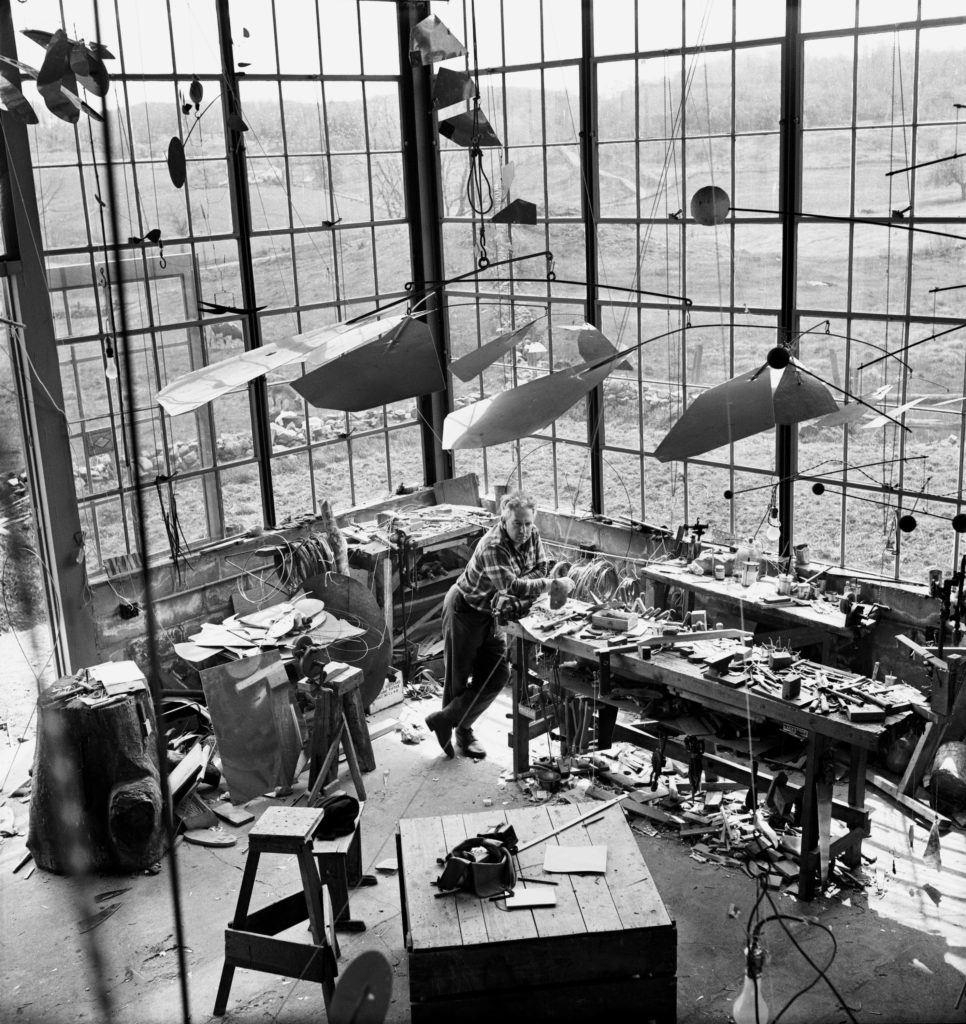
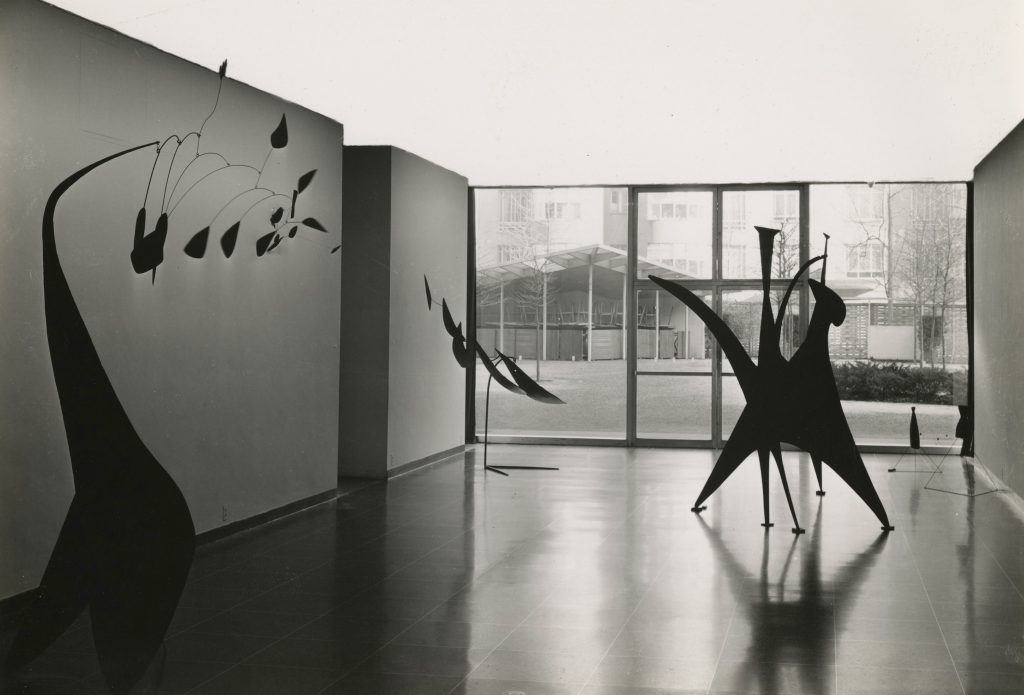
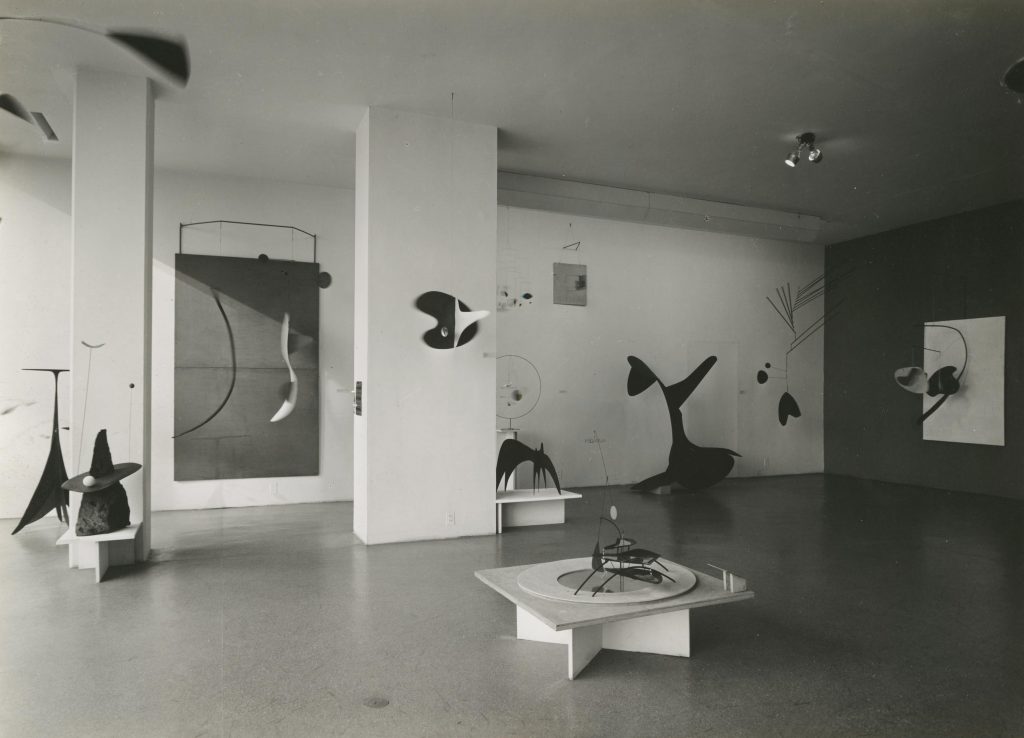
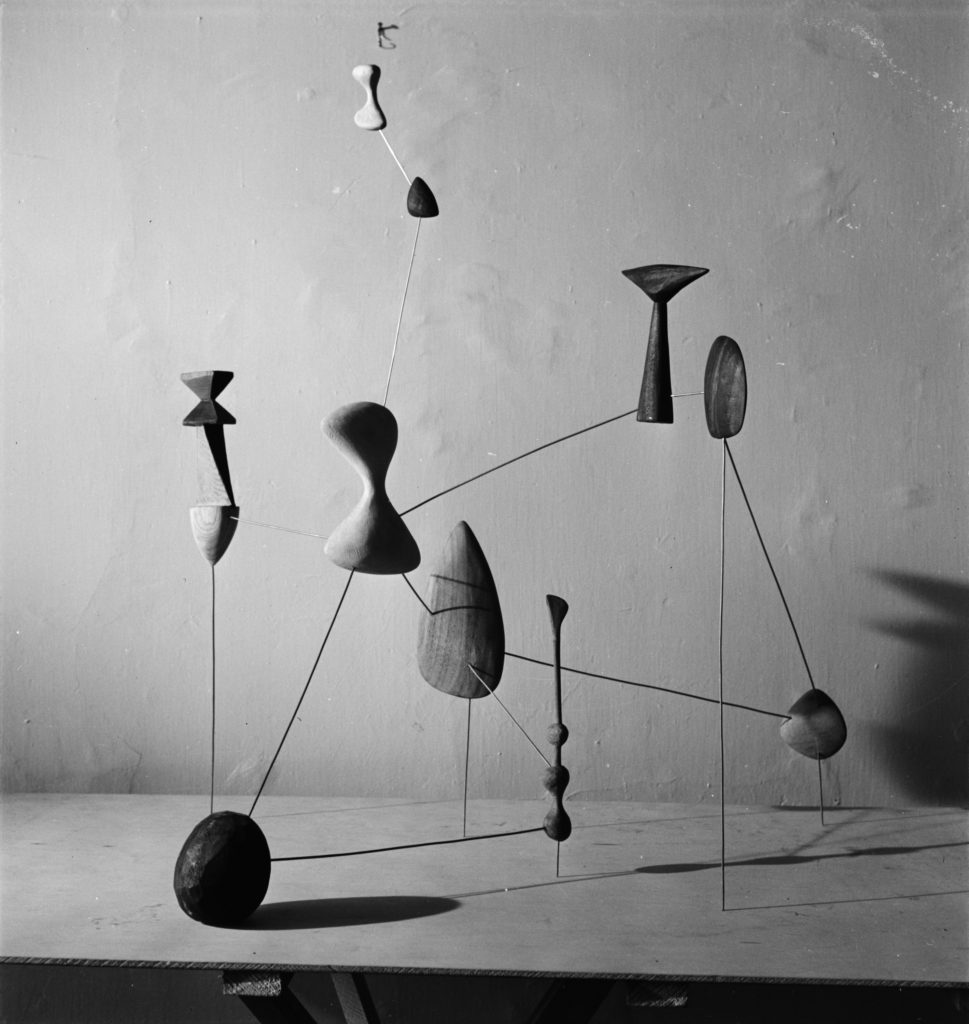
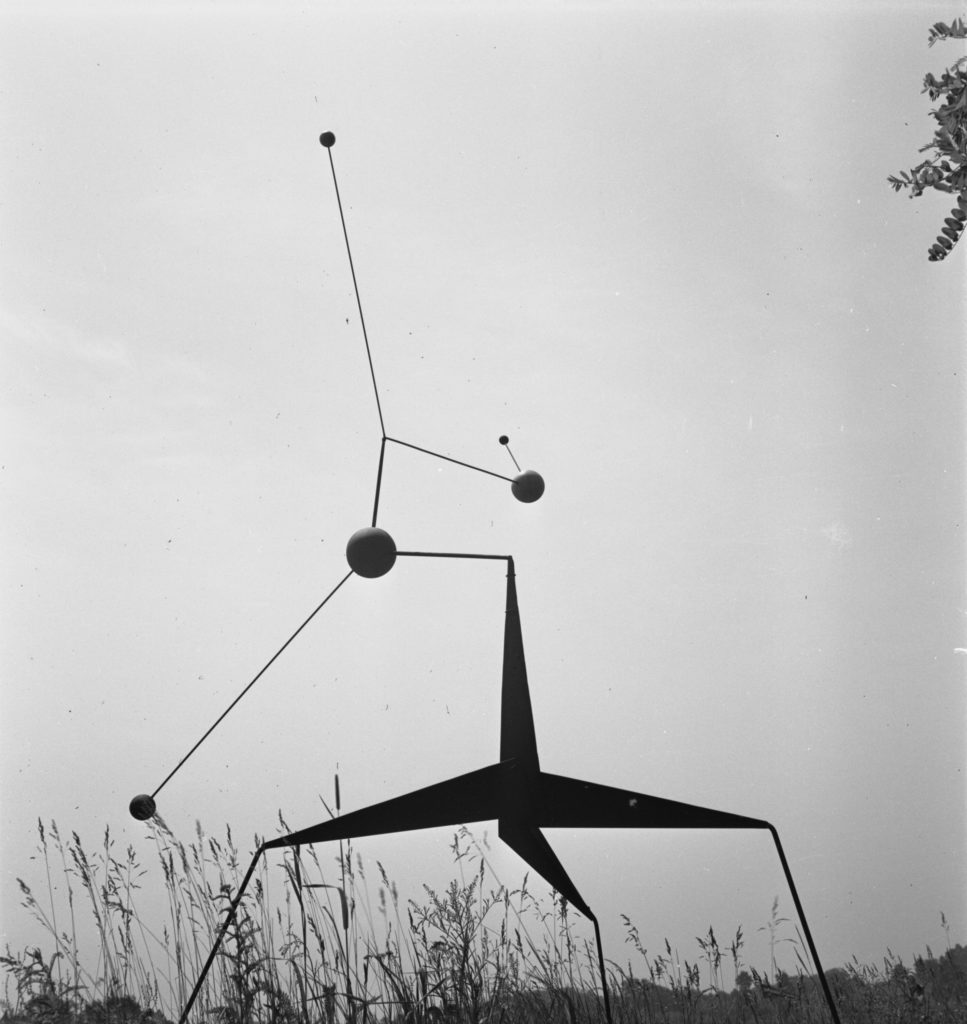
I remember a time, a long time ago now, when artists, connoisseurs, and art lovers were weeping and gnashing their teeth because the silhouette of the Eiffel Tower had just appeared on the Paris skyline, imprinting its filigreed steel patterns on the air, dominating the stone towers and steeples, evoking interest and even admiration already. It was a triumphant blasphemy against all the received wisdom of Architecture and Beauty.
It’s hard to imagine, these days, the enormous upheavals, in all walks of life (material, spiritual, and social), that the scientific breakthroughs of the past century entailed; or how the very foundations of Art have been eroded, broken down, and gradually moved in successive stages onto a new plane of consciousness and understanding.
I am not suggesting for a moment that the present generation has no need for the mysterious activity called Art—an activity that can be defined as an investigation and a completely gratuitous use of the senses and the imagination, involving a transcendental logic that, through balance and proportion, gradually imbues any chosen theme, whether visual, musical, or verbal, with a beginning and an end, an arbitrary “reality,” whose character forces itself onto the person impacted by it, much as the eye is struck by light. It is the components of art, the rules of the game, the materials, and the canons that, under the influence of new interests, have little by little become completely transformed and adapted. I am mainly concerned here with the plastic arts, which have been greatly disrupted by progress in photography and cinema. The history of art of the past fifty years is the history of this breakdown and change.
From the sacrilegious challenge of the Eiffel Tower to Calder, the sculptor of wind, the lunar blacksmith, we have come a long way.
The oeuvre that Calder has brought us from over the Atlantic is a blatant example of the newly acquired situation in the plastic arts; such a precise example that it seems as if Calder has never experienced the anxieties or the doubts about the “disintegration” of objects and subjects that so exercised the generation before him, nor the somewhat puerile arguments about Abstract and Concrete that still continue for some. He has taken off from the last stage with all the confidence of a generation well entrenched in its conquests. To this spiritual “point” should be added certain characteristics that are inherent in his American origins, and we should also note as a new fact that, far from rejecting those origins, he has totally exploited them. He managed to avoid the rigid, out-of-date classical training that until now dominated the tastes of American artists and puts a brake on their originality. This is all the more remarkable given that his mother and father were both official artists of great local repute. He is part of a new generation of American intellectuals whom we are mainly familiar with through homegrown literary works that deal with temperaments and interests far removed from the European range. Their sights are trained on the future and the fruits of science, although this does not exclude the latent memory of pioneer ancestors and a nostalgia for their contacts and struggles with untamed nature.
Sandy Calder was more affected by mechanical dynamism than by the artistic atmosphere in which he grew up, and the four years he spent studying engineering left a permanent mark. He became a stoker on a cargo boat, then a lumberjack in one of the immense forests that here we have seen only in cinema documentaries. This is probably where he got those hefty shoulders that give him the look of something carved out of a mountain.
Not having passed his engineering exams, Calder turned back to art, which had always lingered in his mind. During his time as a lumberjack he had done paintings and he was proud of having managed to get all three of the snow-covered mountains surrounding his forest onto one canvas—perhaps not the kind of artistic goal that we are used to. He was taught to draw by a friend of his mother’s. He did drawings for Police Gazette. But his greatest gift is an astonishing manual dexterity. It is actually quite moving to see his massive, powerful hands holding and twisting tiny pieces of wire with a pair of mechanic’s pliers (his favorite tool) and turning them into silhouettes or jewels, into useful objects or imaginary shapes, all bearing his characteristic imprint.
In 1932 I started going to Calder’s Paris house on the rue de la Colonie. It was always a delight to discover the improvements that he brought to the constraints of everyday household life. In the staircase, for example, there were wires hanging from the top of the house to the bottom, so that the front door could be opened from the top floor without coming down, or letters could be hoisted up. His ingenuity was particularly in evidence in the kitchen and the bathroom. In the bathroom there was a little red flag that would mysteriously appear to show that the pilot on the awkwardly placed water heater was alight. Drawers and faucets were adorned with arabesques of steel or copper wire, ostensibly to make them easier to use, but no doubt also from an unconscious artistic urge.
But Calder had been in Europe since 1926. That’s when his big adventure began. He visited France and England, where, to make a living, he painted the cargo ship that had brought him. In Paris he felt hemmed in; he found it stifling. He kept away from the art scene, danced at the Dôme, and constructed marionette-like novelties activated by strings—an early sign of his potential as an artist. These simple little figures were nonetheless highly realistic and were jointed in such a way as to exaggerate the humor of their characters. However, they only came to life when they were moving. They were masterpieces of design and skillful execution. His Josephine Baker, for example, had a belly made from a coil of copper wire that vibrated at the slightest pressure to set off that irresistible erotic quiver in her body, although the body was not much more than an outline. Other masterpieces included “The Boxing Match” and “The March of the Animals.” The same wit is in evidence in the recent drawings of “The Game of Chess.” I was particularly captivated by the libidinous Queen, the enterprising Knights, the frightened King, and the obtuse, robotic Pawns. Marcel Duchamp added a few good puns to these drawings, which are as witty as the very best animated cartoons in Hollywood. The representations of the miniature circus of which Calder was both creator and operator, and for which he provided a delightful commentary, brought him unexpected fame in all kinds of circles. He became known as the king of wire and string. But he was far from satisfied with this fame. He was looking for something else. He went back to the United States, where he spent a year carving wood. In the meantime he met Léger, Miró, and Mondrian. He was particularly impressed with Mondrian. It may well have been these encounters that fermented his still-confused ambitions. They helped him find his personality, while his genius for mending and making things became the means of expression.
By 1932, the house on the rue de la Colonie would surprise visitors not only because of the strings and wires in the entrance hall but also because most of the bedrooms were taken over by even more curious products of his imagination. They were medium-size machines with many parts and of very diverse appearances. But they were real machines that produced real power and movement. They were unclassifiable works. You could not tell what they were for until they were set in motion. They had small independent motors, each of which created a different rhythmic pattern. One would be a variation on slowness: A disc would move so slowly that for some time the change in its position would be difficult to detect. In another, two balls, one red, the other black, would follow a trajectory at different speeds; one of them performing a sort of visual counterpoint around the other. What they are about is not how they look in space but the rhythm that they create, the line they trace; the arabesque created by their parts. It might be said of these extraordinary works that Calder has sculpted Movement rather than Matter.
Marcel Duchamp gave them the only name which really suits them. They are “Mobiles.”[2] Arp, on the other hand, gave the name “Stabiles” to those works of Calder’s that are not destined for movement.
Calder quickly tired of the automatism of motors; because of their invariability they simply re-create stability. He soon gave up this concept of constrained movement in favor of a new kind of “Mobile,” composed of disparate pieces of iron, wood, or even glass, suspended from the ends of thin metal rods, and swinging in space by dint of their weight and their position. The rudimentary appearance of these “Mobiles” belied the fact that their proportions and their weight were meticulously calculated and coordinated so that a whole set of movements would be triggered by the slightest draft, with each component playing its part in the dance.
After eight years away, Calder came back to Paris with his latest pieces. With his new works he seemed to have achieved an extraordinary degree of control over the relationships between weights and rhythms.
There they were, methodically rigged, and as you walked into the room where they hung, with their long, rustling, moving elements sticking out, you entered an unknown world, where this tangle of wires, iron rods, and pieces of steel gave the hallucinatory impression of the climate and vegetation of the moon or Mars, where the values and comments and aesthetic judgments of humans had lost all meaning (Calder has said himself that his sources of inspiration are the Universe and Cosmography). There is a total disorientation of materials, intentions, and means, but they nonetheless all concur in an intentional, organized, real work of art. Some of the Mobiles bend over with the moving air, like waterweed in a current. Others open up in the opposite direction, at intervals flipping over long metal algae. It is as if, in this troubling atmosphere, even gravity has lost its authority. Heavy pieces of copper representing the detached limbs of a human body lie scattered on the ground. As soon as they are fitted together and mounted on a pivot, they respond to the wind with the sensitivity of a wisp of straw. Some of the most recent pieces proceed from a different intention. These are not mobile but they do have multiple components and the way they are grouped together seems to be the result of some cosmographic cataclysm.
They are slivers, fragments, sections of metal and wood, arranged at a certain distance from one another and fixed in space by stiff rods that connect them to a base on the wall or the floor. It would be nice if a powerful magnet could make the metal rod unnecessary, so that the Constellations (Marcel Duchamp’s term for them) could just hang there in the air, magically suspended by some magnetic force.
Calder has been criticized for working for the Foire de Paris rather than for art galleries. The criticism is unjustified if you think about the problem that his works pose. For an uninitiated public, it has to be admitted that they are puzzling. There is the problem of interpenetration, of equivalence, of rhythmic and plastic values that, as early as 1908 or 1909, were the object of Futurist theories and manifestos. But in those days the intrusion of movement into the idea of what constituted art was conceivable only through the static representation of successive states of movement (arising out of the new experience of animated photography). The concept, therefore, remained strictly plastic. Marcel Duchamp’s Nude Descending a Staircase was the most famous illustration of that stage. In 1915, Ribemont-Dessaignes conceived a genuine Mobile, in the shape of two balls swinging at the end of a rod balanced on a pivot. At the same time, Gabo was addressing the same problem with his dictum that “one should be sculpting Air, not Matter.” Archipenko was introducing wire as a new material for sculpture. Raymond Roussel coined the phrase “Sculpture with umbrella spokes” and I am pretty sure I heard people around Picabia talk about “Sculpture to be touched, not looked at.” All these statements shook up traditional concepts of sculpture, and soon uprooted them completely. The works of several pioneers, among whom I would particularly mention Gabo and Pevsner, gave substance to those new ambitions and established a formula that has already proved to be fertile. Calder, with his engineering skills, has contributed real Mobility to this development. His work represents the successful outcome of a series of experiments that, for more than fifty years, have preoccupied the pioneers of the art form that is most genuinely representative of the concerns of our age.
Galerie Louis Carré, Paris. Alexander Calder: Mobiles, Stabiles, Constellations. Exhibition catalogue. 1946.
Jean-Paul Sartre, Les Mobiles de Calder
Solo Exhibition CatalogueDreier, Katherine S., and Marcel Duchamp. Collection of the Société Anonyme (New Haven: Yale, 1950).
Marcel Duchamp, Alexander Calder
Group Exhibition CatalogueSweeney, James Johnson. Alexander Calder. New York: Museum of Modern Art, 1951.
MonographCalder, Alexander. “What Abstract Art Means to Me: Statements by Six American Artists.” The Museum of Modern Art Bulletin, vol. 18, no. 3 (Spring 1951).
MagazineIn 1937, Calder completed Devil Fish, his first stabile enlarged from a model. He received two important commissions: Mercury Fountain (1937) and Lobster Trap and Fish Tail (1939). His first retrospective was held in 1938 at the George Walter Vincent Smith Gallery in Springfield, Massachusetts, followed by another in 1943 at the Museum of Modern Art in New York.